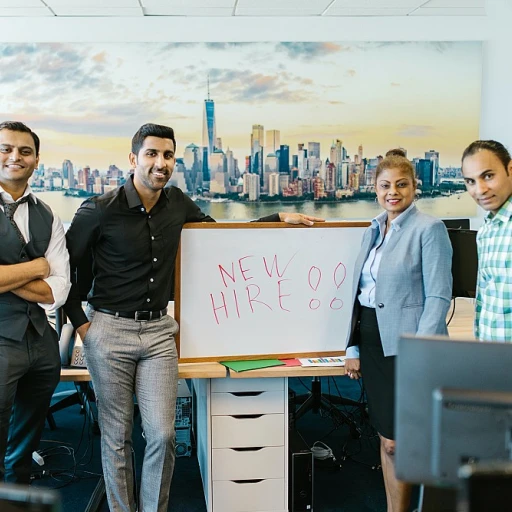
Understanding High Potential Employees
Defining High Potential Employees in the Modern Workplace
In today's rapidly evolving business landscape, understanding the concept of high potential employees is critical for organizations striving to maintain competitive advantage. These employees are often characterized by their capability to excel in their current roles while exhibiting the aptitude and ambition to take on greater challenges. High potential employees typically display certain characteristics that set them apart:- Leadership Skills: They naturally emerge as leaders, navigating teams towards success with strategic planning and effective collaboration.
- Dynamic Problem-Solving Abilities: These individuals are known for their innovative solutions, often leading change initiatives within their organizations.
- Commitment to Development: A keenness for learning and a continuous pursuit of personal and professional growth signify a high potential.
- Strong Interpersonal Skills: They can build robust relationships with peers, clients, and management, crucial for fostering an inclusive and supportive work environment.
Challenges Faced by High Potential Employees
Overcoming Roadblocks and Harnessing Leadership
While it's well-acknowledged that high potential employees possess remarkable capabilities that can propel an organization forward, they often face unique challenges that can impede their progress. Understanding these hurdles is critical for effective leadership within any organization aiming to support this vital group.
- Increased Expectations: High potential employees are often set apart by their exceptional performance and promise for future growth. However, this distinction frequently leads to escalated expectations, resulting in heightened pressure to consistently outperform even themselves.
- Lack of Autonomy: As organizations strive to sculpt their high potential talents into future leaders, they may inadvertently restrict these employees' sense of autonomy. The need to adhere to specific management styles or operational goals can stifle creativity, impacting both current and future performance.
- Burnout and Work-Life Balance: Due to their inherent drive and the accompanying organizational demands, high potential employees might struggle with balancing professional aspirations and personal well-being. Combatting burnout is essential to their sustained success and development.
- Alignment with Leadership: There's often an alignment gap between potential employees and their organizational leaders. Mismatches in strategic planning and development priorities can hinder the realization of full potential.
Utilizing powerful words and strategies to describe effective leadership can help organizations communicate expectations clearly. Leaders should invest in dynamic solutions that appreciate not only the strengths of their high potential teams but also provide room for these talents to grow and learn effectively.
Further, organizations need to encourage a culture where proactive feedback from both peers and supervisors supports healthy progression. By doing so, businesses not only help these employees overcome challenges but also refine their leadership solutions, ensuring a robust pipeline of future leaders.
Implementing Dynamic Leadership Solutions
Driving Organizational Success with Dynamic Leadership Strategies
In today's rapidly changing business environment, leveraging dynamic leadership strategies is crucial for nurturing high potential employees. Organizations aiming to thrive need leaders who can adapt, inspire, and foster growth. Dynamic leadership strategies empower leaders to handle challenges effectively, leading to team success.
To begin with, implementing dynamic solutions focused on leadership development ensures professionals tap into their full potential. This can be achieved through:
- Strategic Planning: Tailor leadership strategies that align with organizational goals. Leaders can create a roadmap for personal and team success, proving beneficial for both business and personal growth.
- Team Solutions: Empower team members to take initiative and lead projects. This builds a sense of ownership and responsibility, fostering innovative solutions.
- Equity and Inclusion: Emphasize diversity and inclusion within teams. A varied team brings in diverse perspectives that enrich problem-solving processes.
Leadership solutions tailored to specific organizational challenges prove effective in optimizing the skills of high potential employees. By integrating these strategies, organizations ensure effective leadership and maintain a competitive edge in their sector.
Moreover, the adoption of cutting-edge technology like MRI software further supports these strategies, optimizing both workflow and result tracking. Progress and accomplishments can be monitored efficiently, making adjustments easier and more precise.
Discover innovative relationship-building techniques that cultivate successful client interactions. Nurturing these relationships fosters long-term commitment from both workforce and clientele, pivotal for sustained organizational success.
Creating a Supportive Environment
Building a Culture of Support and Growth
Creating a supportive environment for high potential employees is crucial for unlocking their full potential and fostering both individual and organizational growth. To achieve this, organizations should prioritize a culture that encourages open communication, continuous feedback, and collaboration it can lead to significant improvements in work performance and job satisfaction.- Emphasizing Continuous Learning: A robust learning and development program should be implemented, offering high potential employees opportunities for skill enhancement and career development. Leadership development initiatives, supported by strategic planning, should address both current and future needs.
- Facilitating Open Communication: Leaders must create channels for transparent communication within teams, allowing team members to voice their ideas and concerns freely. This promotes a sense of equity and inclusion, making individuals feel valued and respected.
- Promoting Diversity, Equity, and Inclusion: Organizations must embrace diversity equity as a standard, ensuring that all employees have equal access to resources and opportunities for advancement. Equity inclusion supports a healthier work environment and encourages diverse perspectives.
- Implementing Technology Solutions: Leveraging technology such as MRI Software can help organizations streamline processes, enhance human resources operations, and improve team solutions. Digital tools aid in efficient management and provide data-driven insights for organizational development.
Measuring Success and Growth
Tracking Progress and Achievements
Measuring the success and growth of high potential employees is crucial for both their personal development and the organization’s success. Effective leadership involves setting clear, achievable goals and using dynamic solutions to monitor progress. Leaders should establish key performance indicators (KPIs) that align with the organizational objectives and the individual’s career aspirations. This strategic planning allows for a balanced assessment of performance and potential.
Utilizing Feedback for Development
Feedback is a powerful tool in the development of high potential employees. Regular performance reviews and constructive feedback sessions help in identifying areas of improvement and recognizing achievements. Leaders must foster an environment where feedback is viewed as an opportunity for growth rather than criticism. This approach not only supports the employee’s development but also enhances the overall team solutions.
Leveraging Technology for Insights
Incorporating technology into the evaluation process can provide deeper insights into an employee’s performance and potential. Tools like mri software can help in tracking progress and identifying trends over time. These insights can inform leadership development programs and ensure that high potential employees are on the right path to reaching their full potential.
Aligning Growth with Organizational Goals
For high potential employees to truly thrive, their growth must be aligned with the broader goals of the organization. This requires a dynamic leadership approach where leaders and human resources work collaboratively to integrate individual development plans with organizational strategies. By doing so, organizations can ensure that their high potential employees are not only growing but also contributing to the business’s success.
Evaluating Long-term Impact
Finally, assessing the long-term impact of high potential employees on the organization is essential. This involves looking beyond immediate achievements and considering how these employees contribute to the organizational culture, innovation, and leadership solutions. By evaluating their influence on diversity equity and inclusion, as well as their role in fostering a supportive and effective work environment, organizations can better understand the true value of their high potential talent.
Future Trends in Leadership and Employee Development
Adaptation: The Future of High Potential Leadership and Employee Development
The landscape of leadership and employee development is ever-evolving, and understanding future trends is vital for leveraging high potential employees to their fullest. Organizations can expect several transformations in how leaders and teams adapt to new demands and opportunities.- Integration of Technology: As technology continues to advance, dynamic solutions like artificial intelligence and machine learning will play a significant role in human resources strategies. These innovations will facilitate better assessment, strategic planning, and the effective management of high potential employees.
- Emphasis on Diversity and Inclusion: Equity inclusion initiatives will become more central. Organizations must foster an environment where diverse teams thrive, aligning with broader business goals and enhancing team development.
- Remote and Hybrid Work Models: With changes in work environments, the ability to lead remote and hybrid teams effectively will be crucial. Leaders will need to develop skills for engaging team members across various settings while maintaining organizational support.
- New Leadership Styles: Dynamic leadership approaches will gain traction, focusing on flexibility and adaptability. Leaders will be required to adopt innovative leadership solutions to address unique challenges in a shifting business landscape.
- Continuous Learning and Development: Organizations will be investing more in ongoing training and development programs to ensure high potential employees reach their full potential. This not only helps in retention but also prepares them for future leadership roles.
- Emphasis on Organizational Development: Strategies will likely include greater collaboration with organizational development consultants to sustain growth and development for both leaders and their teams.












